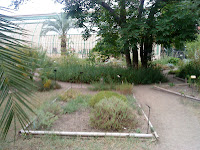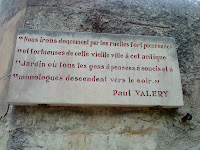 Le Jardin des Plantes, Montpellier
Le Jardin des Plantes, Montpellier
Bienvenue aux amateurs de jardin!
I'm chasing a few deadlines so the next few postings will be more like bulletins for now and probably a bit rough around the edges. But gardens are racking up like cards in my hand - it's time to play a few. Trimming and pruning can wait a while.Last week I spent a few days in Montpellier. Other holiday plans had fallen through for unforeseeable reasons, but I managed to book something a couple of days beforehand. At first, I'd thought of going to Marseille by Eurostar but, with only a short break to play with, the 7-hour journey wasn't the best option. An hour and twenty minutes after take-off from Gatwick, we were in Montpellier. Une lumiere couleur
The heat struck us first - washing over and through you like a forcefield. And then the sunlight glowing on the runway and irradiating the palm trees and flowering shrubs lining the roads into town. Van Gogh and Gauguin came to mind - on the second to last day of our stay, we went by TGV to Sete where there was a Dufy exhibition at the Paul Valery museum (gardens surrounding the museum opposite).  Dufy's South of France paintings are lit up with that azure and golden light - yet in the exhibition notes there were a few quotations from the man himself acknowledging its magnetic quality while distinguishing it from a kind of illumination even more essential for a painter: A suivre la lumiere solaire, on perd son temps. La lumiere de la peinture, c'est tout autre chose, c'est une lumiere de repartition, de composition, une lumiere couleur.Le peintre a besoin d'avoir sans cesse sous les yeux certaine qualite de lumiere, un scintillant, une palpitation aerienne qui baigne ce qu'il voit.
Dufy's South of France paintings are lit up with that azure and golden light - yet in the exhibition notes there were a few quotations from the man himself acknowledging its magnetic quality while distinguishing it from a kind of illumination even more essential for a painter: A suivre la lumiere solaire, on perd son temps. La lumiere de la peinture, c'est tout autre chose, c'est une lumiere de repartition, de composition, une lumiere couleur.Le peintre a besoin d'avoir sans cesse sous les yeux certaine qualite de lumiere, un scintillant, une palpitation aerienne qui baigne ce qu'il voit.
[Apologies for lack of accents as couldn't track these down on Blogger, and pasting in Word documents brings up 'typescript error' . . .. On the subject of glitches, just to mention that unpredictable font sizes are courtesy of the ghost in the machine.]
Heroes of the Plant WorldMaybe it was this year's Van Gogh exhibition at the RA that put the idea of going to the South in my mind. Another part of Montpellier's appeal was that it featured in the lives of the sixteenth-century herbalists and botanists I'd spent years reading about: in particular, two botanists trained at the university's distinguished medical school, de l'Obel (after whom the lobelia is named) and de l'Ecluse, who influenced John Gerard, gardener to Sir William Cecil and so ultimately helped shaped English gardens and botany. (Incidentally, in the next century, the magnolia would be named after another Montpellier medical graduate, Pierre Magnol.)De l'Ecluse translated an influential herbal by Dutch botanist Dodoens, which appeared in English in 1557, translated, in turn, by Henry Lyte; some think that Gerard based his famous
Herbal on de l'Ecluse's translation of Dodoens. There was another botanical domino effect when de l'Ecluse went on to found the first botanic garden at Leiden, bringing his collection of tulips with him and helping to initiate 'tulip fever'.
From the middle ages onwards, the area around Marseilles was both the gateway to the south, in terms of trade, and renowned for its health-giving properties, resulting in a high concentration of merchants and doctors and, in turn, boosting Montpellier's School of Medicine. 
The Jardin des Plantes is the oldest botanic garden in France, dating from 1593. Henri IV commissioned his physician Pierre Richer de Belleval, known as the 'father of scientific botany', to create a space modelled on the garden in Padua, laid out in 1545 (the earliest botanic garden was created two years earlier, in Pisa). Montpellier's botanic garden was the prototype for the Jardin des Plantes, in Paris, 1623 (England's first botanic garden, at Oxford, was created in 1621). Instead of dried samples, students were able to study real plants as materia medica - and in glorious surroundings . . .
Luxe, calme et volupteThe garden is huge in scale, covering 4.5 acres. It's also free and open late - till 8 - and, after experiencing the mighty heat of the Midi the day before, which drove everyone, even the locals, into the shade, we thought that by around 7 it would be cool enough to enjoy exploring the place. We made our way there by tram, after spending a day at the beach. On the way, though, it was still so warm that I thought we might just want to sit and read in the shade - as do many of Montpellier's students.
But as soon as we entered the garden, it was just a pleasure to walk along the avenues and paths, and our books weren't needed - like perfect days at the beach where you bring something to read, but it's enough to look and listen to the sea and enjoy the sunshine.

I've run out of time to write much more but just to mention some highlights: myrtle hedges in various stages of being sculpted into shape, enclosing palm trees;

the perfect balance between trees and stonework (classical-style arches and wide stone walls and benches); rows of huge terracotta pots on pedestals;

an avenue of cypresses;
a lotus pond backed by an orangerie and conservatory, with enormous flowers with palest pink satin petals and bizarre showerhead-like seedpods;


students reading and writing on a little hill, stretched out on wide stone walls beneath a dense canopy of trees;

a bamboo forest;
a monumental greenhouse in the process of being restored;
the calm in the air, sweet scent of leaves, deep, gentle light and pellucid colours.

Last, but not least, a hexagonal herb garden divided into a symmetrical pattern of small beds each planted with a single species (an arrangement modelled on Italian botanic gardens).

An e
xotic tree stands at the centre:
sapindus mukorossi, from China
. 
About twenty minutes before closing time, the headgardener took to his bicycle, furiously ringing his bell, hurtling along the paths like a man possessed (you can just make him out in the photo below, whizzing across at the top of the picture, about a third of the way in from the left), in huge contrast with the leisurely people, some strolling arm in arm, making their way out.

We were among the last to leave, around ten to eight (it was so lovely I could easily have stayed longer), and, although he looked tired and a little fraught after his high-speed circling of the garden - I joked with him about warning people to leave 'a toute vitesse' - he was happy to talk to us about the history of the garden and generously tried to look up details of a tour, but unfortunately the last for the season had taken place the day before. Next time . . .
Lastly, it was something to see beautifully engraved quotations by Paul Valery lining the paths. Here's the first, about the perfect time of day to visit the garden:
Le moment le plus agreable dans l'allee Cusson: de dix heures du matin a midi. C'est un admirable lieu de lecture cette allee sureleve au coeur du Jardin des Plantes entres deux murs de verdures variees.
A great place to read - a raised walk between two green walls - perhaps Valery meant the shaded path up a flight of steps where we'd met students lounging (and doing a little reading and writing while they were at it).And the second:

Plants, people, poetry - what more could you ask for?
Next routine: more exotica, at Great Dixter
A suivre . . .

 With autumn closing in, although it's 'game over' in many gardens, the place is still flourishing.
With autumn closing in, although it's 'game over' in many gardens, the place is still flourishing.
 Inspired by news of an exhibition about Christopher Lloyd at the Garden Museum, and realising that I'd probably been missing something, I made plans for a visit last Easter before seeing the exhibition. But our long-drawn-out, cruel winter put a stop to that. The gardening diary on Great Dixter's website warned that the snowdrops had only just come up . . . So I went to see the exhibition instead and was charmed, moved and inspired by Christopher Lloyd's life and garden - and came away resolved to see the garden when the dahlias were out. Another motive for wanting to go then was that I'd developed an unsatisfied hunger to be surrounded by these flowers since the sensational avenue of dahlias that lined the tennis courts in Preston Park mysteriously disappeared not long ago.
Inspired by news of an exhibition about Christopher Lloyd at the Garden Museum, and realising that I'd probably been missing something, I made plans for a visit last Easter before seeing the exhibition. But our long-drawn-out, cruel winter put a stop to that. The gardening diary on Great Dixter's website warned that the snowdrops had only just come up . . . So I went to see the exhibition instead and was charmed, moved and inspired by Christopher Lloyd's life and garden - and came away resolved to see the garden when the dahlias were out. Another motive for wanting to go then was that I'd developed an unsatisfied hunger to be surrounded by these flowers since the sensational avenue of dahlias that lined the tennis courts in Preston Park mysteriously disappeared not long ago.

 (peacock topiary newly trimmed, left, with shears in the foreground - pruning starts in late August and usually takes till November to finish it, but then it'll hold until the end of summer again), a productive garden, with a bale of giant pumpkins at the entrance, the superb Lutyens layout, to name just a few other attractions. There's also the house, with its magnificent medieval hall and library where my eye was caught by books by Christopher Lloyd's friends. There were several titles by Derek Jarman, who was there a lot, a guide told me, since he lived in nearby Dungeness.
(peacock topiary newly trimmed, left, with shears in the foreground - pruning starts in late August and usually takes till November to finish it, but then it'll hold until the end of summer again), a productive garden, with a bale of giant pumpkins at the entrance, the superb Lutyens layout, to name just a few other attractions. There's also the house, with its magnificent medieval hall and library where my eye was caught by books by Christopher Lloyd's friends. There were several titles by Derek Jarman, who was there a lot, a guide told me, since he lived in nearby Dungeness.  I loved seeing a few locals rolling up less than an hour before closing time for a sundowner wander around the grounds.
I loved seeing a few locals rolling up less than an hour before closing time for a sundowner wander around the grounds.

